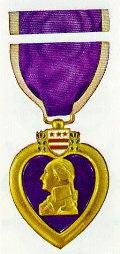History of the Badge of Military Merit / Purple Heart

At his headquarters in Newburgh, New York, on August 7, 1782, General George Washington devised two new badges of distinction for enlisted men and noncommissioned officers. To signify loyal military service, he ordered a chevron to be worn on the left sleeve of the uniform coat for the rank and file who had completed three years of duty “with bravery, fidelity, and good conduct”; two chevrons signified six years of service. The second badge, for “any singularly meritorious Action,” was the “Figure of a Heart in Purple Cloth or Silk edged with narrow Lace or Binding.” This device, the Badge of Military Merit, was affixed to the uniform coat above the left breast and permitted its wearer to pass guards and sentinels without challenge and to have his name and regiment inscribed in a Book of Merit. The Badge specifically honored the lower ranks, where decorations were unknown in contemporary European Armies. As Washington intended, the road to glory in a patriot army is thus open to all.”
Three badges were awarded in the waning days of the Revolutionary War, all to volunteers from Connecticut. On May 3, 1783, Sergeants Elijah Churchill and William Brown received badges and certificates from Washington’s hand at the Newburgh headquarters. Sergeant Daniel Bissell, Jr., received the award on June 10, 1783.
Churchill was a 32-year old carpenter from Enfield who entered the 8th Connecticut as a private on July 7, 1775. On May 7, 1777, he re-enlisted for the duration of the war as a corporal in the 2d Continental Light Dragoon Regiment, later the 2d Legionary Corps, and was promoted to sergeant on October 2, 1780. He was cited for gallantry in action at Fort St. George near Brookhaven on Long Island, at Coram, New York, in November 1780, and at Tarrytown, New York, in July 1781.
A native of Stamford, Brown enlisted in the 5th Connecticut Regiment as a corporal on May 23, 1775, and re-enlisted as a private on April 9, 1777, for the duration in the 8th Connecticut. He was promoted to corporal on May 8, 1779, and to sergeant on August 1, 1780, transferring with the consolidation of units to the 5th Connecticut on January 1, 1781, and to the 2d Connecticut on January 1, 1783. No record of his citation has been uncovered, but it is believed that he participated in the assault on Redoubt No. 10 during the siege of Yorktown.
Bissell, from East Windsor, enlisted on July 7, 1775, as a fifer in the 8th Connecticut Regiment, and on April 1, 1775, signed on for the duration as a corporal in the 5th Connecticut. He became a sergeant on September 1, 1777, and ended the war with the 2d Connecticut. Under Washington’s direct orders he posed as a deserter in the city of New York from August 14, 1781, to September 29, 1782, relaying valuable information to the Continental command.
The award fell into disuse following the Revolution and was not proposed again officially until after World War I. On October 10, 1927, Army Chief of Staff General Charles P. Summerall directed that a draft bill be sent to Congress “to revive the Badge of Military Merit.”
For reasons unclear, the bill was withdrawn and action on the case ceased on January 3, 1928, but the Office of The Adjutant General was instructed to file all materials collected for possible future use.
The rough sketch accompanying this proposal showed a circular disc medal with a concave center in which a relief heart appeared. The reverse carried the legend: For Military Merit.
A number of private interests sought to have the medal reinstituted in the Army. One of these was the board of directors of the Fort Ticonderoga Museum in New York.
On January 7, 1931, Summerall’s successor, General Douglas MacArthur, confidentially reopened work on a new design, involved the Washington Commission of Fine Arts. His object was medal issued on the bicentennial of George Washington’s birth.
Miss Elizabeth Will, an Army heraldic specialist in the Office of the Quartermaster General, was named to redesign the newly revived medal, which became known as the Purple Heart. Using general specifications provided to her, Ms. Will created the design sketch for the present medal of the Purple Heart. Her obituary , in the February 8, 1975 edition of The Washington Post newspaper, reflects her many contributions to military heraldry.